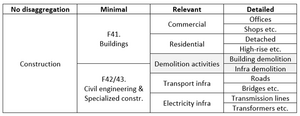IEBUILDING
[UNDER DEVELOPMENT]
General Scope and Connection with Climate Mitigation
Introduction
The simple MS Excel model served as input to a discussion on how macro-economic representation of Circular Economy strategies relevant to building construction could be improved based on available Industrial Ecology data (such as material intensities per unit of floorspace) and tools (such as dynamic stock modelling).
The reason for focusing on buildings only, in this example model, is that buildings comprise an important part of in-use material stocks (so their production is responsible for a large share of greenhouse gas emissions) and their long lifetimes cause a typical lag between material demand (for construction) and waste-generation (after demolishing). This is an important dynamic when studying the potential for a Circular Economy (or a circular construction sector) that is typically missing in macro-economic modelling. This model explores which steps and what data would be required for economic models to better capture these explicit material-related stock dynamics, with buildings as an example.
The model provides a hypothetical example-setup - in an Input-Output Table data structure - that starts with the assumption that it is possible to dis-aggregate the economic data on the construction sector into building-related construction & other construction activities (mostly related to infrastructure). This should be possible based on NACE rev. 2 classification (building-related construction activities are tracked under code F41), and would allow to connect to a wealth of knowledge on building-related material demand in the research field of Industrial Ecology that often relate building material use to the physical floor space (in square meters) of the buildings. So, the model exemplifies an attempt to bridge the level of detail typically found in economic models (left side, typically in monetary terms or $/yr) and the higher level of detail typically found in Industrial Ecology models (right side, typically expressed in physical units, such as kg or square meter of floor space), as shown in the figure below.
The MS Excel model links the monetary and the physical data by assuming that sectoral activity related to building construction leads to a given total amount of added building floor space by assuming a fixed floor space price. The total amount of floor space is then further dis-aggregated into residential and commercial floor space as informed by (Deetman et al., 2020). This allows to implement a different lifetime dynamic & different material-composition to the two different building classes (residential & commercial). The implications for material use are subsequently calculated by applying material intensities in terms of kg per square meter (kg/m2) for 3 different commercial building types and 3 different residential building types, each with 4 possible construction types. These assumed building practices can be changed over time to represent the effects of material substitution.
Model Scope
Though the model provides a hypothetical case study, the example setup has a global geographic coverage (with a distinction between 2 regions, being Europe and the 'Rest of the World'). The dynamic changes are tracked over a 10 year period. Drivers of growth are exogenous through hypothetical population change, leading to (simplified) changes in economic activity for 10 economic sectors. Implications on material demand are only elaborated for the construction activities related to buildings, and cover 3 materials being Steel, Concrete and Wood.
Model Development
- Status: Finished
- Environment: MS Excel
- Documentation: In-file & on this site
- Source code:
Circular Economy Features
The simple discussion model allows to assess the effects of building construction on total material use by representing the demand for construction materials (kg/yr), the size of the in-use stocks (kg) as well as tracking the volume of demolition waste flows by material (kg/yr). The total waste flows are complemented with simple assumptions on recycling practices, which allow to assess the potential effects of higher recycling rates in the construction sector. Adjusting the model drivers or the floor space price allows to assess the effects of rethinking the ever growing need for floor space by assuming smaller houses or lower per capita floor space demand.
The model is mostly suited however, to show the effect of reducing material demand through construction material substitution, for example the substitution of typical construction practices based on steel & concrete by wood-based alternatives.
CE strategies and connection with climate change mitigation.
The model allows to assess the reduction potential in terms of reduced material inputs into the construction sector. The implications in terms of Greenhouse Gas emissions are not explicitly covered in the simple discussion model, but (if required) could be explored in the same way as done in the example by (Zhang et al., 2021).
Synergies and trade-off between the R word in the context of the stylized model
Insights for Analytical Framework
This section should highlight the features relevant for the CIRCOMOD analytical framework. They should be linked with the previous section which provide more details.
- Key mechanisms and interactions within CE strategies that lead to changes in GHG emissions.
- Tool exploration (demonstrating ideas before implementing them in large-scale quantitative models)
- Communication key CE dynamics (to the broader audience)
Refinement, Integration, Future Development
The following sections are optional and should be completed only if they are relevant.
Refinement process
Please describe how the stylized model will be improved/refined in the CIRCOMOD project.
Integration
Highlight the features to be integrated in larger model in the CIRCOMOD project.
Future features of the model
Not yet implemented, planned model developments, if any.
Sources
Deetman et al. 2020 - "Modelling global material stocks and flows for residential and service sector buildings towards 2050", Journal of Cleaner Production, Volume 245, 1 February 2020, 118658, https://doi.org/10.1016/j.jclepro.2019.118658
Zhang et al. 2021 - "Global greenhouse gas emissions from residential and commercial building materials and mitigation strategies to 2060" Nature Communications Volume 12, 6126 https://doi.org/10.1038/s41467-021-26212-z

